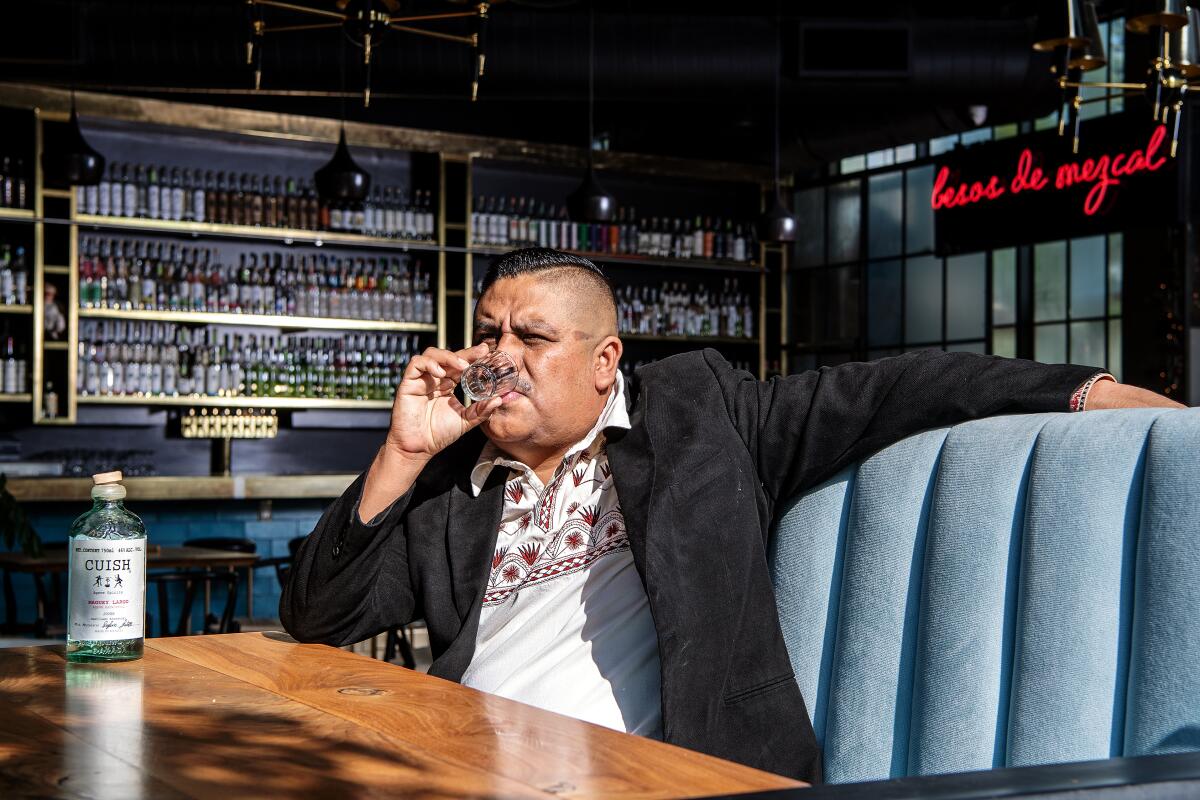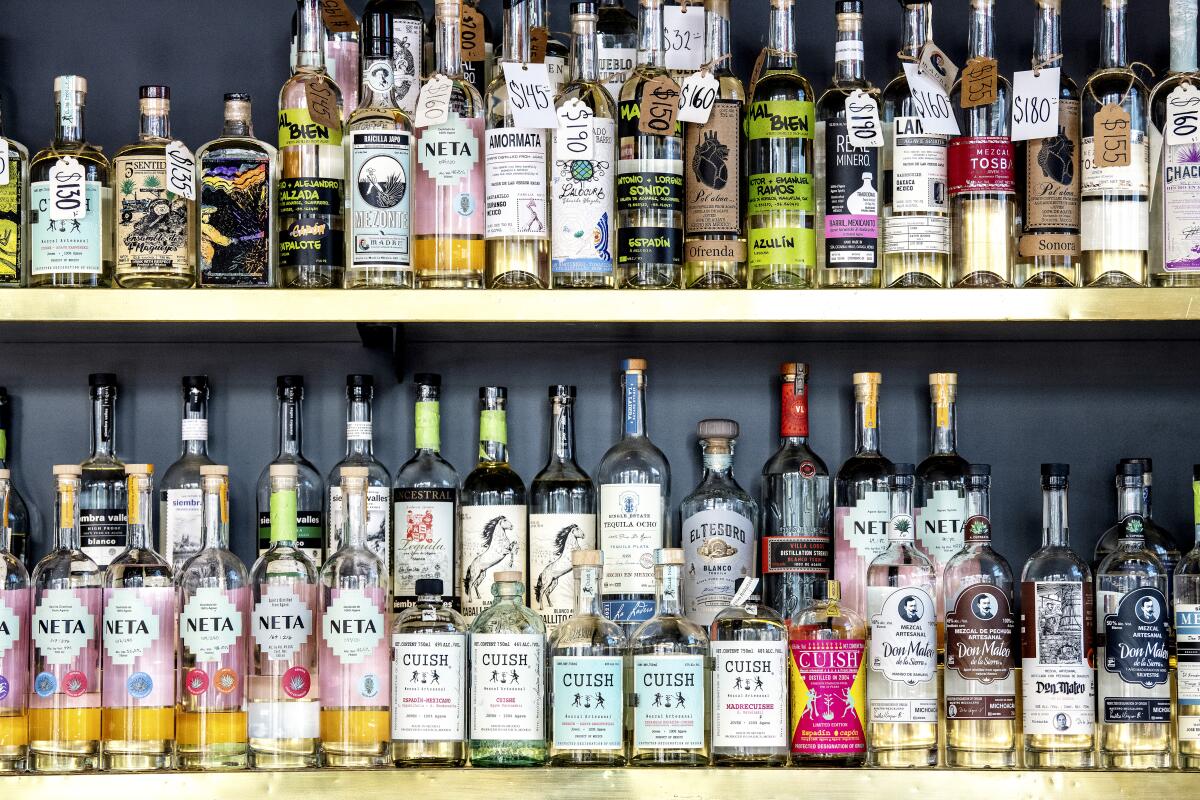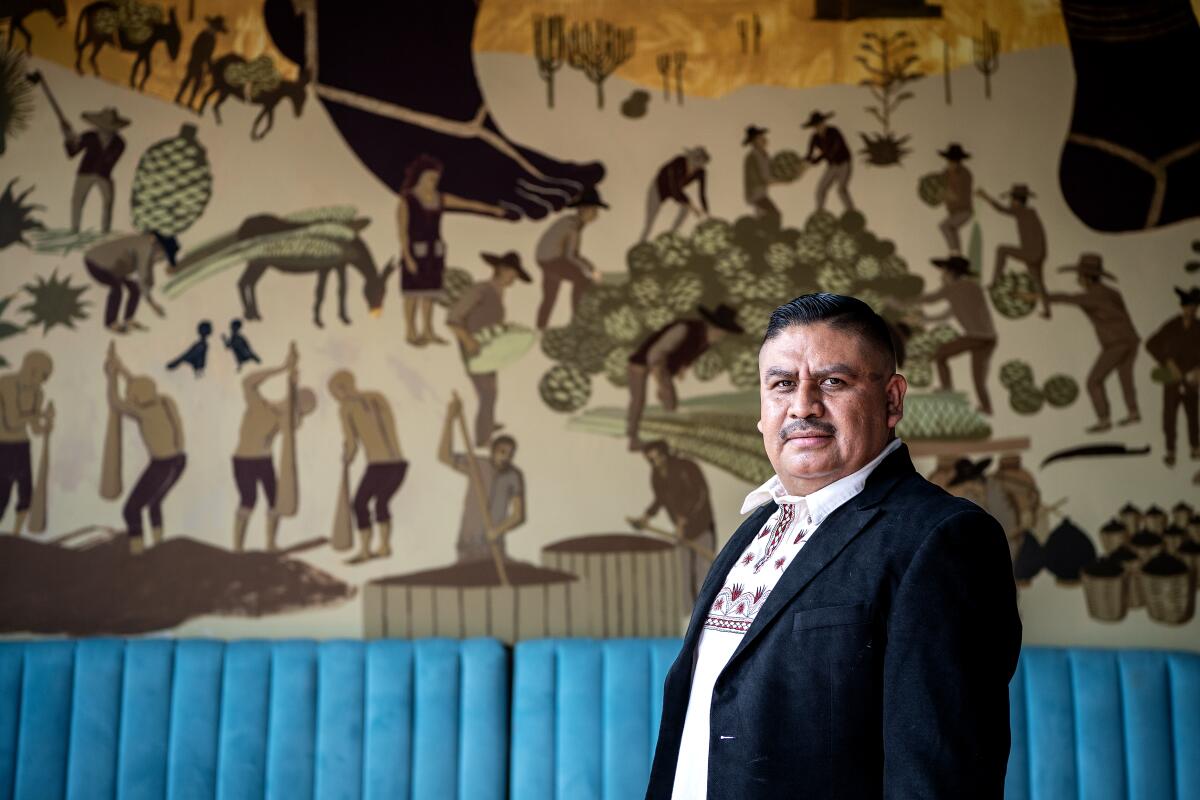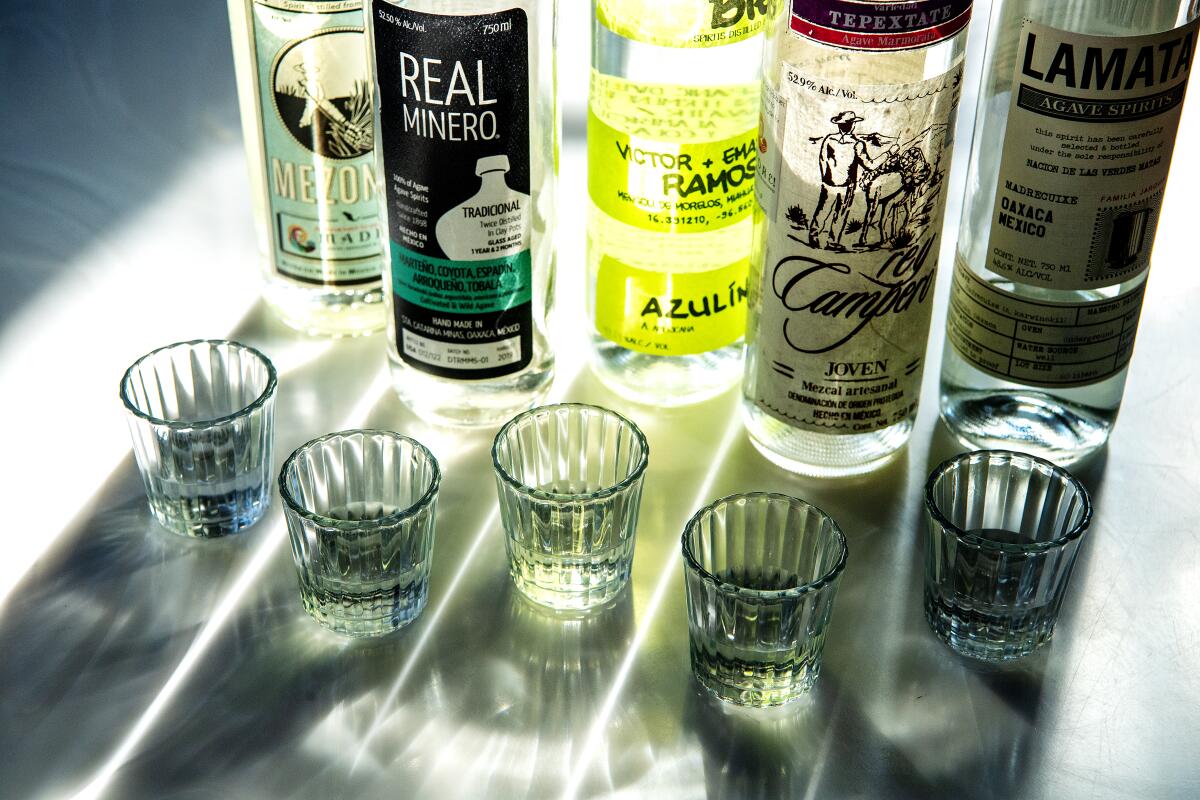Stop calling it ‘smoky’: Everything you need to know to be a better mezcal drinker

Los Angeles may be the best city in which to sip this complex agave spirit — but when does it become too much of a good thing?
- Share via
Mezcal is certainly having its moment. The U.S. became the world’s largest market for the spirit in 2019 — surpassing even Mexico — and production increased by almost 10% in 2020. What’s more, Drizly, the liquor delivery service, reported that its mezcal sales jumped 600% in the same year.
Its popularity has risen astronomically, in part due to its increased incorporation into cocktails, which is often the way American imbibers first encounter the spirit; it’s used frequently as a substitute for other spirits in drinks like a smoky margarita or a mezcal mule. But even if we’re drinking more of it, some of us don’t know that much about mezcal, so here are a few facts you should savor while you’re sipping.
More than 40 varietals of agave may be used in the creation of mezcal (a word derived from the Nahuatl word for “oven-cooked agave”). Though it’s often thought to have arrived in Mexico with the Spaniards, there’s evidence the spirit’s roots go back to pre-Hispanic times (it’s certainly the oldest distilled spirit in the Americas).
Traditionally, the agave piñas, or hearts, are baked in a pit for several days as they absorb flavors from the wood smoke and earth. Afterward, they ferment aerobically as they lie above ground before they’re crushed by hand or under a donkey-pulled stone. Then a mash is created by incorporating water or even pulque (a pre-Hispanic drink made from the fermented sap of agave) for funkier mezcals. Mezcal is frequently double distilled in copper; in rarer cases, it might be distilled in clay or even tree trunks.
Ivan Vasquez, the Indigenous owner of Los Angeles’ Oaxacan restaurant Madre — which has locations in Torrance, Palms and the Fairfax District (and plans for a new Madre in Santa Clarita) — has an almost puritanical commitment to high-quality, sustainable mezcal and destilados de agave (agave spirits made outside the 10 certified states comprising the mezcal denomination of origin), as well as the independent producers behind them. “In mezcal, you taste the terroir even more than in wine,” he says.

He believes that Los Angeles is the best place to taste these spirits, which might seem a bold declaration. But it’s one that Vasquez is confident making, in no small part due to his own outsize collection, which is considered to be unmatched by many enthusiasts and industry veterans. (Times restaurant critic Bill Addison says Vasquez is “one of the foremost mezcal evangelists in America.”)
Direct relationships with independent producers enable Vasquez to stock his shelves with rare, small-batch bottles; they also supply him with bottles to sell to his customers. Other restaurants with collections he recommends? Gracias Madre in West Hollywood, Maestro in Pasadena and Neat on Pico Boulevard.
The urgency with which Vasquez is promoting traditional producers is apparent. A majority of the mezcaleros (someone who distills mezcal) who are stewards of techniques used in distilling small batches of mezcal and destilados in Mexico are in their 80s, and the time-honored techniques are at risk of dying out, especially if the demand goes the way of mass production, he says.
Mezcal and destilados made with traditional methods will result in a spirit with an alcohol by volume that is 44% or above. And even though the minimum for mezcal certification is only 35% ABV, there is no mezcal bottle at Madre that has an ABV under 44%. “Most mezcaleros and palenques [distilleries],” Vasquez says, “aim for 44% ABV and above. But the minimum has gone down to 40% because it’s convenient for mass production.”
Though 90% of all agave distillate is made in the state of Oaxaca, Vasquez also has been importing agave spirits made in the other states of Mexico. “There are uncertified destilados that are often just as good or better than some mezcal,” Vasquez says.

He’s turned many customers into mezcal enthusiasts after taking them through a tasting flight, showing them how high-quality mezcal exhibits a wide range of aromas, differences in mouthfeel and beginning and finishing notes on the palate.
“When I first started drinking mezcal, it was in cocktails, and I loved it,” says Bruce Endsley, one of Madre’s regulars. “Then I tasted it neat and thought it was too strong and too hot. But then I went to Madre in Torrance to taste Ivan’s extraordinary collection, and then I knew [mezcal] was great. ... There’s so many different flavors, and you have the history and culture Ivan tells you about.”
Noah Dickinson, a hospitality industry veteran, was already a mezcal enthusiast when he was hunting down a particular bottle of Real Minero ensemble mezcal (a bottle of mezcal blending distillates made from different varietals of agave). After Dickinson reached out via Instagram, one of the mezcaleros of Real Minero referred him to Vasquez. “[The mezcalero] kept calling it the ‘magic bottle,’ and said Ivan might have one or two bottles available,” Dickinson recalls. “He had one left, and it was pretty unheard of in the U.S. where somebody could sell you a bottle at the restaurant. But he appreciated my enthusiasm and was willing to sell it to me. It didn’t come cheap, but collectors like me can be obsessive. And that’s how we met.”

Vasquez says 75% of Madre’s mezcal sales are of the sipping variety, and only 25% are used in mixed cocktails. “We sell several flights that make up a lot of the share that we sell for sipping. Plus, bartenders always recommend their favorite mezcal to customers, which also helps,” he adds.
Here is an overview of what they’re learning about mezcal and destilados de agave at Madre, enabling them to take their knowledge and appreciation to the next level.
Good mezcal and destilados do not taste smoky
“Smoky” is the most oft-used description for mezcal, and many drinkers have come to expect overwhelmingly charred notes, often driving bartenders to use it as a cocktail base. But if smoke is the main note you’re tasting in the spirit, it’s somewhat flawed, Vasquez says.
Thoughtfully produced mezcal and destilados de agave exhibit much diversity and nuance on the palate. Look for notes that run the gamut: herbal, oily, peppery, citrusy, vanilla, woodsy, mineral and floral, as well as some specific fruits like melon.
Glass-aged mezcal is great for beginners
Aging a mezcal or destilados in glass is different from aging whiskey in barrels. (Though you’ll find some mezcal aged in barrels, it’s a practice that Vasquez has described as a corruption of the industry by Western practices.) The spirit becomes “smoother, more subtle and mellower — but it still retains its ABV” if aged in glass, he says. It’s a technique that has passed down from generation to generation — an evolution from using clay.

Vessels used for distillation and materials used for fermentation are varied and a mark of tradition
Mezcal and destilados de agave can be distilled or fermented in rawhide, clay, tree trunk, copper and even plastic. Taste for gamey, mineral or woodsy notes as you learn about how the mezcal in your glass was distilled. Look for the kind of still that was used, which is often printed on the bottle label if it is an artisanal mezcal.
Agave varietals have different names in different states
Agave angustifolia is most commonly known as espadin because that’s what is most used in mezcal (it has a shorter harvest time) and also what it’s called in Oaxaca. However, in Puebla, the same varietal is called espadilla; it’s liñeno in Jalisco and zacatoro in Guerrero. Agave marmorata is referred to as tepeztate in Oaxaca but pichomel in Puebla. The list goes on and on, but paying attention to the genus and species of the agave serves as an equalizer across pre-Hispanic languages, states and regions.
Destilados de agave from the north have their own names
Raicillas and Bacanoras also are distilled from agave. Raicillas hail from two distinct regions in Jalisco (coastal or mountains) or Nayarit. Bacanoras are solely from Sonora. “They’re more herbal and don’t have as many mineral notes as mezcal from Oaxaca,” Vasquez says. “There’s more citrus. It’s more about the soil or terroir, and you can definitely taste the vehicle they use for maturation — often copper or wood.”
Don’t miss out on destilados made from capón agaves
Capón refers to agaves whose quiote, or reproductive stalks, are cut off a few months before harvesting. This sends the energy that would have been expended sending the flowering stalks up into the sky back into the piña, or heart of the agave, instead. Vasquez says, “What you get is an explosion of stronger flavors, as well as sugar content. But it’s also controversial. This is because the method prevents the agave from reproducing.”
More to Read
Eat your way across L.A.
Get our weekly Tasting Notes newsletter for reviews, news and more.
You may occasionally receive promotional content from the Los Angeles Times.










